If you are looking for perfect safety, you will do well to
sit on a fence and watch the birds....
Wilbur Wright |
By
transcending human limitations, the Wright Brothers opened the door to new capabilities
and ushered in new ways of thinking and new ways of being for all the world's inhabitants. When the powered Flyer took to the air on December
17, 1903, it also gave flight to human possibilities that had never existed before. Only 66 years later, Neil Armstrong and Buz Aldrin
touched down on the surface of the moon.
In
1970, when I set out to build a full-size replica of the Wright Brothers' 1902 glider,
there was no practical justification for building it, much less for flying it. It was built mainly as a way to retrace the
footsteps of giants - to see what they saw, to touch what they touched, and to feel what
they felt at the controls of this awkwardly graceful bird.
It was an adventure beyond words to describe.
And in the end, I was left with a profound sense of the spirit that must
have propelled the Wright Brothers on to unreasonable success and a deep appreciation for
the giants they truly were.
In November, 1972, the finished glider
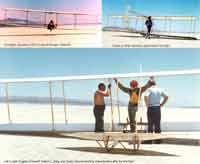 was towed aloft from the dry lake bed at Lake
El Mirage, California for its maiden flight. This
was the first time since the Wright Brothers' experiments that a 1902 Wright glider had
taken to the air. It had soft and gentle
flight characteristics, but the pitch instability reported by the Wright Brothers was
still present. The biggest problem,
however, was borrowed from Samuel Pierpont Langley - the "launch mechanism." Since the replica was towed by a station wagon,
pull on the tow line connected to the lower wing caused it to pitch up while under tow and
pitch down when released. In free flight,
however, the machine was quite docile, despite its pitch instability. By staying focused on pitch attitude, it was easily
controlled. Later, the glider was donated to
the California Museum of Science and Industry (now California Science Center) where it has
since been on display. was towed aloft from the dry lake bed at Lake
El Mirage, California for its maiden flight. This
was the first time since the Wright Brothers' experiments that a 1902 Wright glider had
taken to the air. It had soft and gentle
flight characteristics, but the pitch instability reported by the Wright Brothers was
still present. The biggest problem,
however, was borrowed from Samuel Pierpont Langley - the "launch mechanism." Since the replica was towed by a station wagon,
pull on the tow line connected to the lower wing caused it to pitch up while under tow and
pitch down when released. In free flight,
however, the machine was quite docile, despite its pitch instability. By staying focused on pitch attitude, it was easily
controlled. Later, the glider was donated to
the California Museum of Science and Industry (now California Science Center) where it has
since been on display.
During remodeling at the Science Center in 2001, the glider was badly damaged and
returned for repair and refurbishment. While
being refurbished it was almost totally destroyed in a tragic fire, so it was completely
rebuilt. The reconstructed glider, built entirely to Wright Brothers' specifications
and with only the elevator hinges from the original replica, is now in its permanent home
at the California Science Center. Like
its predecessor, this new glider is fully operational and capable of flying.
Robert Q. Riley

Photo Album
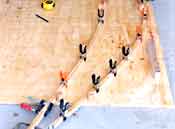 |
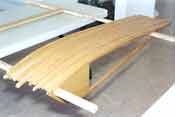 |
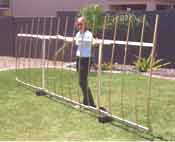 |
| Curved components, such as the wing ribs, wing tips, and skids are laminated of
ash. Image shows leading- and trailing-edge elevator members in the laminating jig.
|
Ash ribs are laminated in a jig. Later they are trimmed to
length by matching their curvature on the skeleton of a wing, as shown above.
|
Michelle Beckner holds the finished upper right-hand wing panel.
The wing is now ready for the fabric. |
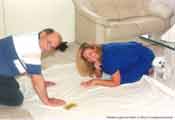 |
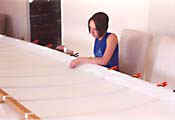 |
 |
|
Robert Q. Riley and Michelle Argyle fix a misaligned rib pocket.
Sewing was done at the home of Robert Q. Riley. |
Fabric wraps over the front spar and is sewn to itself. Here, Melissa Beckner is sewing the front spar cover. |
Left to right, Marie Caruso, Melissa Beckner and Cindy Beckner
hand-stitch the rear spare cover into place. |
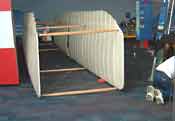 |
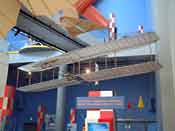 |
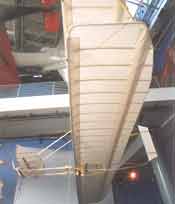 |
|
1902 Wright glider being assembled at the California Science
Center. |
In its permanent home at the California Science Center.
Looking up toward the ceiling reveals two modern jet fighters (not visible in the photo)
high above the Wright Brothers' glider |
A photograph taken with a wide angle lens exaggerates
the wing span. Actual wing span is 32 feet |
|